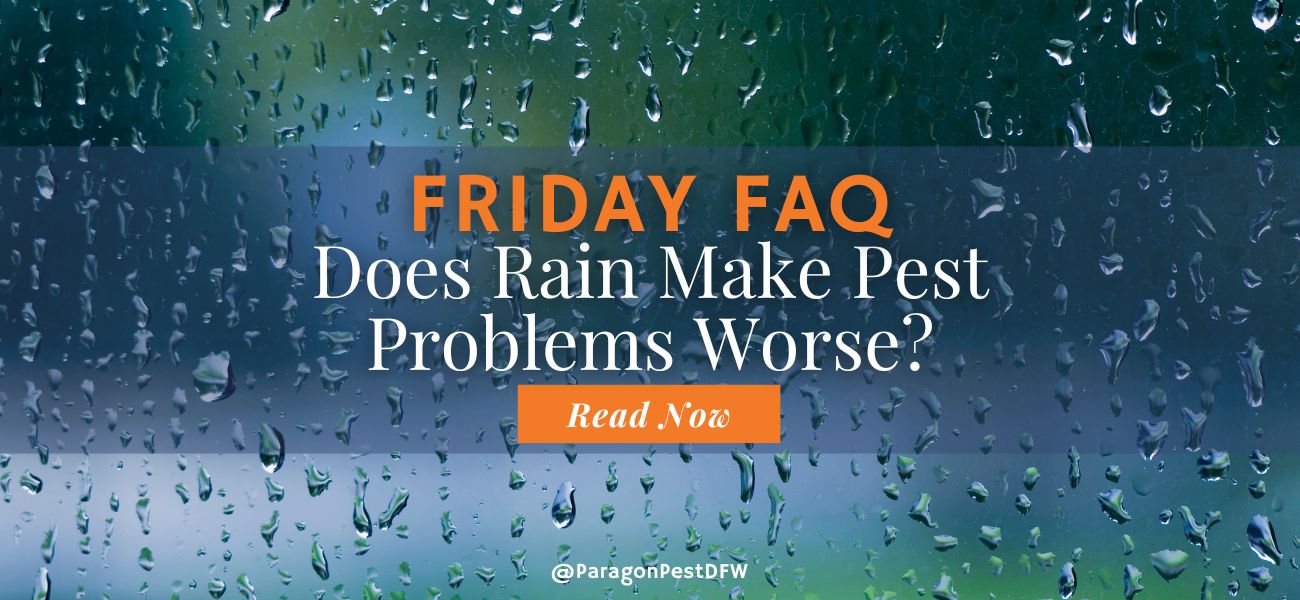FAQ: Does Rain Make Pest Problems Worse?
When the weather turns wet in the Dallas-Fort Worth area, we often hear the same question from concerned homeowners:
"Why am I suddenly seeing more pests in my home after it rains?"
The short answer? Because rain doesn’t just water your lawn—it also displaces pests. When their environments flood, they head for higher, drier ground—and often, that means your house.
Let’s break down exactly why rain increases pest pressure and how proactive pest control can help you stay ahead of the problem.
Ants: Small Insects, Big Disruption
Ants are highly sensitive to moisture. When their underground tunnels and nests begin to flood, they immediately seek safer shelter—often indoors.
That’s why you may suddenly see long trails of ants along your walls, countertops, or baseboards right after a storm. They’re not just exploring—they’re evacuating.
What helps:
Cleaning up crumbs and moisture regularly
Sealing common entry points such as windows, doors, and utility gaps
Targeted baiting and barrier treatments to eliminate the colony at its source
Roaches: Thriving in the Damp
Rain creates the perfect environment for roaches—especially American and German cockroaches. These pests often live in storm drains, sewers, and yard debris, and they’re pushed out when those areas flood.
Once inside your home, roaches look for moisture, food, and shelter—usually in kitchens, bathrooms, and utility rooms.
Prevention tips:
Repair plumbing leaks and avoid standing water
Keep food sealed and trash cans covered
Schedule pest control services that address both interior and exterior access points
Rodents: Seeking High Ground
Mice and rats are particularly opportunistic after heavy rain. When burrows, crawlspaces, and ground-level shelters flood, they look for dry, elevated spaces—attics, garages, and even wall voids.
Rodents don’t need much of an opening to enter your home. Even a gap the size of a coin can be an open invitation.
Signs to watch for:
Scratching or movement sounds, especially at night
Droppings near baseboards, appliances, or storage
Nesting materials in insulation or stored items
Why Moisture Increases Pest Pressure
Rain doesn’t create pests—but it concentrates them.
After a storm, pests that typically stay hidden in soil, mulch, or debris are suddenly on the move. If your home offers warmth, dryness, or access to food, it becomes an ideal fallback location.
This shift in pest behavior is what we refer to as increased pest pressure—and without a preventative strategy in place, your home becomes a target.
The Power of Proactive Pest Control
Waiting to see bugs before calling for help is like waiting for a flood before sealing the windows.
At Paragon Pest Control, we focus on proactive pest protection that’s built to last—rain or shine. Our services are tailored for Texas homes and designed to:
Create long-lasting protective barriers
Use rain-resistant products for reliable control
Identify and seal potential pest entry points before pressure builds
Routine pest control means fewer surprises, even when the weather shifts suddenly.
Serving Dallas-Fort Worth Homes Year-Round
Rain may be out of your control—but pests inside your home don’t have to be.
If you’re seeing signs of ants, roaches, or rodents after a storm, it’s time to act. Our expert technicians are here to assess, treat, and protect—before the next downpour hits.
Call Paragon Pest Control at 972-435-9797 or visit paragonpestdfw.com to schedule a service.


